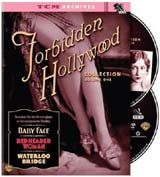Movies |
Forbidden Hollywood Collection, Vol. 1
By
Published: Dec 12, 2013
Category:
Drama
Weekend Classic: Cold where you are? Don’t even start. As you read this, I’m off to Duluth for the weekend — and it’s minus 9 degrees there. Very much looking forward to a possible high of plus 15. So my thought for this Weekend Classic: heat.
Violence? In American movies, it’s appropriate for viewers of almost all ages.
Sex? If she’s not married and she fools around, she’ll be punished.
The reality of film ratings is more complicated than this, but for all purposes, Hollywood loves a man who brandishes a gun and loathes a woman who bares a nipple. And it’s been that way from the start of the film business. Cadres of righteousness leaned on Hollywood, and Hollywood, anxious not to have the government step in, obligingly censored itself.
The Production Code of 1930 drew clear lines for feature films: Good wins, evil dies, marriage is sacred. But the economic hardship of the Depression was more urgent than making theaters safe for the god-fearing; the Code was ignored until 1934, when bluestockings threatened to boycott all Hollywood films. At that point, Hollywood began to enforce the Code. And it continued to do so — ready for this? — until the ratings system was adopted in 1968.
But forget about the prudes. A few filmmakers did, and in the first four years of the Depression, they turned out some movies about sexual relationships that didn’t involve holding hands, proposing on bended knee and then having a heart-to-heart with her dad.
Turner Classic Movies has collected some of the most important of these films, slapped on a “lurid” cover photo and given its collections an irresistible title. Don’t be fooled — the closest thing to hard-core in these three films is a brief shot of Jean Harlow’s breast. Just as well. These movies are subversive, titillating — and unusually interesting — without acres of naked flesh. [To buy “Forbidden Hollywood Collection, Vol. 1” from Amazon.com, click here.]
Start with “Waterloo Bridge,” released in 1931. It was directed by James Whale, who had such a hit with it he was asked to direct “Frankenstein.” His star was Vivienne Leigh — not shabby casting.
“Waterloo Bridge” is a straightforward World War I melodrama. During a London air raid, Clark meets a young soldier. They’re crazy about one another, but he’s rich and well-bred and she’s a chorus girl. Or was. Now she’s a whore. That’s the big news she has to deliver to her besotted beau, and it takes her the entire movie to do it. He doesn’t care; he’ll marry her anyway.
As every woman living in England knew, the life expectancy of soldiers at the front was measured in minutes — World War I wiped out an entire generation of young men. So marrying a soldier was a shrewd idea; the widow was at least assured of his death benefits. But Clark’s too moral. Or maybe just conflicted, for throughout the movie, she acts against her own interests. You’ll want to scream at her to stop talking and jump the lug. But this film’s not that forbidden.
“Red-Headed Woman” was released in 1932, and you can’t accuse Jean Harlow — her trademark blonde hair nowhere in evidence — of looking out for anyone but #1. Written by Anita Loos and F. Scott Fitzgerald, this rags-to-riches story starts with a snappy dismissal of the idea behind the Loos bestseller, “Gentlemen Prefer Blondes,” and proceeds to show how any guy would tumble for this redhead.
All the men here are saps. But if they were stronger, they’d be no match for Harlow — she’s a stalker, a worthy model for Glenn Close in “Fatal Attraction.” What she wants, she gets. And if he’s married…well, too bad for the wife. There’s a shooting. Inappropriate sex (with her chauffeur). The dialogue is racy — when a lover slaps her out of frustration, Harlow says, "Hit me again! I like it!” And there is, for the deeply immature, that notorious flash of flesh. “Red-Headed Woman” was a big hit.
“Baby Face,” released in 1933, was so hot that Turner offers two versions — even before it was released, the studio censored it. You can see why. Barbara Stanwyck plays a young woman who works at her father’s speakeasy in a grimy factory town. That job also includes sex with important politicians — her dad’s her pimp.
But Stanwyck has a friend, an older man who preaches the gospel of Nietzsche. The philosophy of self makes chilly sense, and when escape is possible, she jumps a train bound for the big city. A railroad inspector spots her — and, without flinching, she pays her fare the way she’s learned how.
Does she like sex? She’s indifferent. She understands its power, and she exploits it, first with an office boy, then with the young John Wayne, then with his boss (in the ladies room of their office), and, sleeping her way still higher, with his boss. Marriage leads to money, but not happiness — she’s looking for the exit when her husband begs her for financial help. I won’t spoil the ending(s).
What’s fun about these films is their cultural transparency. Watching them, you can see just what behavior was allowed for media role models in their media roles. Off-camera, of course, those people did what those people do.
That’s hypocrisy? You bet. But that’s a plus — these films make you nostalgic for a time when a few frames of female nudity and a couple of raunchy lines of dialogue were all the thrills you needed. On a Saturday night, with some friends and a bowl of popcorn, I’ll bet they’re still entertaining.
BONUS VIDEO


